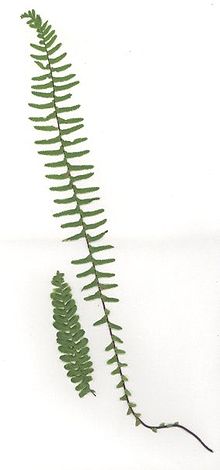Asplenium platyneuron
| Ebony spleenwort | |
|---|---|
 |
|
| A. platyneuron fronds; the smaller frond on the left is sterile, the longer frond on the right is fertile. | |
| Scientific classification | |
| Kingdom: | Plantae |
| Division: | Pteridophyta |
| Class: | Polypodiopsida/Pteridopsida (disputed) |
| Order: | Polypodiales |
| Family: | Aspleniaceae |
| Genus: | Asplenium |
| Species: | A. platyneuron |
| Binomial name | |
|
Asplenium platyneuron (L.) Britton, Sterns & Poggenb. |
|
| Synonyms | |
|
Acrostichum platyneuros L. |
|
Acrostichum platyneuros L.
Asplenium ebeneum Aiton
Asplenium polypodioides Sw.
Asplenium trichomanoides Michx. nom. illeg.
Chamaefilix platyneuros (L.) Farw.
Tarachia platyneura (L.) Momose
Asplenium platyneuron (syn. Asplenium ebeneum), commonly known as ebony spleenwort or brownstem spleenwort, is a fern native to North America east of the Rocky Mountains and to South Africa. It takes its common name from its dark, reddish-brown, glossy stipe and rachis (stem and leaf axis), which bear a once-divided, pinnate leaf. The fertile fronds, which die off in the winter, are darker green and stand upright, while the sterile fronds are evergreen and lie flat on the ground. An auricle at the base of each pinna points towards the tip of the frond. The dimorphic fronds and alternate, rather than opposite, pinnae distinguish it from the similar black-stemmed spleenwort.
The species was first described in 1753 by Linnaeus as Acrostichum platyneuros, although Linnaeus' type drew on material from several other species as well. It was more commonly called Asplenium ebeneum, a name published by William Aiton in 1789, until the rediscovery and revival of the Linnaean epithet in the late Nineteenth Century. A number of forms and varieties of the species have been described, but few are recognized today; in particular, larger and more fertile specimens, those with more or less toothed leaves, and those with proliferating buds are considered to fall within the natural range of variation of the species, and do not require taxonomic distinction. A. platyneuron f. hortonae, a sterile form with the pinnae cut to toothed pinnules, and f. furcatum, with forking fronds, are still recognized.
...
Wikipedia

